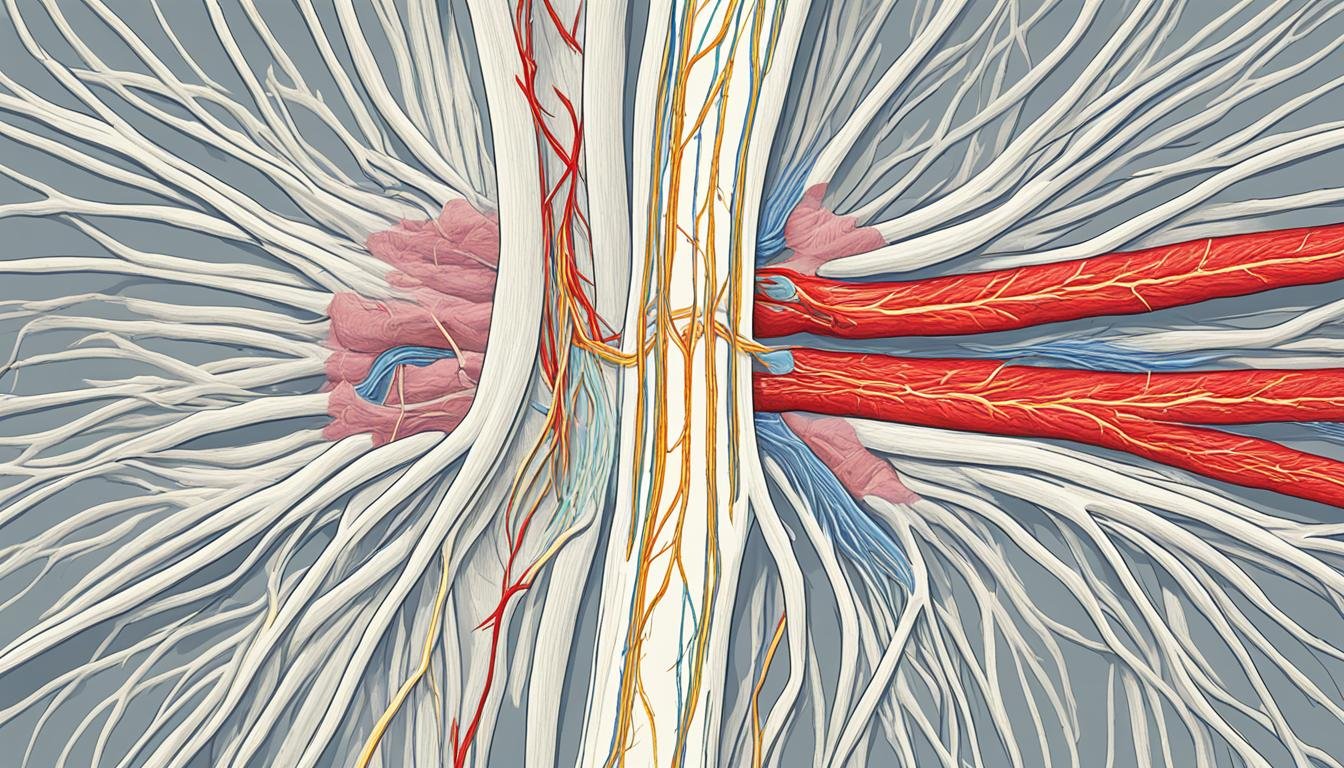Did you know about the 17,000 new spinal cord injury cases yearly in the United States? These injuries can lead to lasting changes in strength, feeling, and body functions below the injury level. It’s vital to understand spinal cord injuries to promote awareness and preventative actions.
Key Takeaways:
- Spinal cord injuries can cause permanent changes in strength, sensation, and other bodily functions.
- Common causes of spinal cord injuries include motor vehicle accidents, falls, acts of violence, sports injuries, and diseases.
- Risk factors for spinal cord injuries include being male, being between the ages of 16 and 30, alcohol use, and engaging in risky behaviors.
- Preventive measures and safety precautions can help reduce the risk of spinal cord injuries.
- If you or a loved one has suffered a spinal cord injury due to someone else’s negligence, legal experts like the team at Super Attorneys Of Irvine can provide guidance and support in seeking compensation.
Understanding Spinal Cord Injuries
Spinal cord injuries come in two types: traumatic and non-traumatic. Traumatic injuries happen suddenly due to impacts like car crashes or falls. Non-traumatic injuries stem from diseases or conditions.
Arthritis, cancer, and other conditions can lead to non-traumatic spinal cord injuries. To avoid these, we should follow safety measures and care for our health.
Traumatic spinal cord injuries might appear sudden. Yet, we can prevent many by being careful and taking safety steps. Knowing the causes helps us stay safe.
“Prevention is always better than cure.”
Safety measures can lower the chances of spinal cord injuries. It’s vital to be cautious when driving, playing sports, and in everyday life. Looking out for dangers is key to our well-being.
Want to know more about spinal cord injuries? Keep reading. We will cover symptoms, how it’s diagnosed, risks, complications, and treatments.
Symptoms and Diagnosis
A spinal cord injury can bring many symptoms, depending on the injury’s severity and location. Realizing these signs is key for quick diagnosis and treatment. If you notice any symptoms of a spinal cord injury, it’s critical to get medical help right away.
Common Symptoms
There are several common symptoms of a spinal cord injury:
- Loss of movement: Inability to move limbs or loss of coordination.
- Changes in sensation: Altered feeling or loss of sensation in certain areas of the body.
- Loss of bowel or bladder control: Inability to control urination or bowel movements.
- Exaggerated reflex activities or spasms: Involuntary muscle contractions or reflex movements.
- Changes in sexual function: Sexual dysfunction or loss of sexual sensation.
- Pain or stinging sensation: Persistent pain or stinging in the affected area.
These symptoms can greatly affect everyday life and need quick medical help.
Emergency Symptoms
In emergencies, some symptoms could mean a serious spinal cord injury. If you or someone else shows any of these emergency signs after an injury, it’s important to get help fast:
- Extreme back pain or pressure.
- Weakness or loss of control in the body.
- Numbness or loss of feeling in the hands or feet.
- Loss of bladder or bowel control.
- Trouble with balance and walking.
- Trouble breathing.
It’s safest to treat the injury as spinal until proven otherwise. Don’t move the injured person because it could worsen the injury.
Recognizing the symptoms early and getting quick medical help can lead to better recovery chances for spinal cord injuries.

Anatomy and Types of Spinal Cord Injuries
The spinal cord plays a key role in how our bodies function. It runs from the brain all the way to the lower back. Surrounded by vertebrae, these bones keep it safe. Inside, a complex network of nerves sends messages between the brain and our bodies.
The spinal cord is at risk of injury. These injuries depend on where and how severe the damage is. For example, injuries can be in the neck, mid-back, lower back, or near the tailbone. Each part controls different body functions, so injuries at different spots affect us in unique ways.
There are two main kinds of spinal cord injuries: incomplete and complete. With incomplete injuries, some nerve signals still get through, meaning there can be some movement or feeling below where the injury happened. Complete injuries, however, block all signals. This causes total loss of movement and sensation below the injury.

Knowing about spinal cord injuries helps doctors and therapists provide the best care. They can make personalized treatment plans. This approach aims to help individuals recover as much as possible, improving their life quality.
Risk Factors for Spinal Cord Injuries
Some factors raise the risk of injuring the spinal cord. Men and people aged 16 to 30 face a higher chance of traumatic spinal cord injuries. Older adults often get these injuries from falls.
Using alcohol and risky actions, like ignoring safety in sports, can also make injuries more likely. Diseases that weaken bones or joints, such as arthritis or osteoporosis, add to the risk too.
Knowing these risk factors is key to avoiding spinal cord injuries. Wear protective gear and follow safety rules to stay safe. Living healthy also lowers the chance of these injuries.
Complications and Treatment of Spinal Cord Injuries
Spinal cord injuries deeply affect a person’s life. They can lead to many problems. These issues need detailed care and handling.
Complications of Spinal Cord Injuries
Some common problems include:
- Issues with bladder and bowel control: Injuries can affect bladder and bowel function, causing incontinence or retention.
- Pressure injuries: People with these injuries may get pressure sores because they can’t move much or feel properly.
- Circulatory problems: Problems with blood flow, like low pressure and clots, can occur because the spinal cord is damaged.
- Stiffness and changes in muscle tone: Spasms and stiffness can cause unbalanced muscles and limited movement.
- Autonomic dysreflexia: This is when the nervous system causes dangerous blood pressure spikes.
- Pain: Many people feel constant pain due to nerve damage or other changes.
Treatment for Spinal Cord Injuries
Efforts to treat these injuries include:
- Fixing the spine: Surgery might be needed to fix misalignments or instabilities.
- Removing damaged parts: Operations can take out anything pressing on the spinal cord.
- Physical therapy: Rehab with physical therapy helps regain strength and movement.
- Pain management: Different medicines can help ease the pain and discomfort.
- Assistive devices: Items like wheelchairs and braces improve movement and independence.
Getting the right medical care quickly is crucial for those with spinal cord injuries. Continuous support from specialists is also key. Dealing with the complications and using effective treatments helps people live better lives.
Conclusion
Spinal cord injuries deeply affect a person’s health. Knowing the causes and risks is key to avoiding them. We can lower the chances of these injuries by being safe and cautious.
If a spinal cord injury has impacted you or someone you care about because of another’s mistake, getting legal help is crucial. The Super Attorneys Of Irvine team works hard to aid spinal cord injury victims. They guide them through the legal hurdles to get the compensation they need. This can help with medical bills, rehab costs, and more.
Get in touch with Super Attorneys Of Irvine by calling 949-996-9546 or visiting //businesslawyersirvine.com/. They’re ready to help with your spinal cord injury case.

